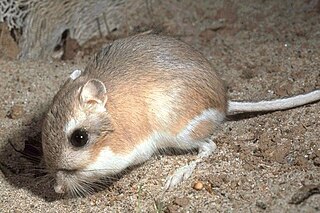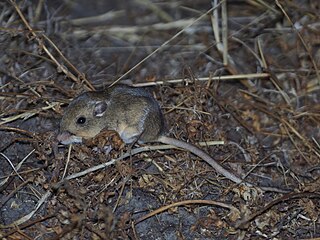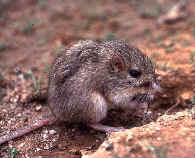
Kangaroo rats, small mostly nocturnal rodents of genus Dipodomys, are native to arid areas of western North America. The common name derives from their bipedal form. They hop in a manner similar to the much larger kangaroo, but developed this mode of locomotion independently, like several other clades of rodents.

Heteromyidae is a family of rodents consisting of kangaroo rats, kangaroo mice, pocket mice and spiny pocket mice. Most heteromyids live in complex burrows within the deserts and grasslands of western North America, though species within the genus Heteromys are also found in forests and their range extends as far south as northern South America. They feed mostly on seeds and other plant parts, which they carry in their fur-lined cheek pouches to their burrows.

Perognathus is a genus of pocket mouse. Like other members of their family they are more closely related to pocket gophers than to true mice.

Perognathinae is a subfamily of rodents consisting of two genera of pocket mice. Most species live in complex burrows within the deserts and grasslands of western North America, They feed mostly on seeds and other plant parts, which they carry in their fur-lined cheek pouches to their burrows.

The rock pocket mouse is one of 19 species of pocket mice in the genus Chaetodipus. It is sometimes grouped in the genus Perognathus.

The hispid cotton rat is a rodent species long thought to occur in parts of South America, Central America, and southern North America. However, recent taxonomic revisions, based on mitochondrial DNA sequence data, have split this widely distributed species into three separate species. The distribution of S. hispidus ranges from Arizona in the west to Virginia to the east and from the Platte River in Nebraska in the north to, likely, the Rio Grande in the south, where it meets the northern edge of the distribution of S. toltecus. Adult size is total length 202–340 mm (8.0–13.4 in); tail 87–122 mm (3.4–4.8 in), frequently broken or stubbed; hind foot 29–35 mm (1.1–1.4 in); ear 16–20 mm (0.63–0.79 in); mass 50–250 g (1.8–8.8 oz). They have been used as laboratory animals.

Chaetodipus is a genus of pocket mouse containing 17 species endemic to the United States and Mexico. Like other members of their family such as pocket mice in the genus Perognathus, they are more closely related to pocket gophers than to true mice.

The desert pocket mouse is a North American species of heteromyid rodent found in the southwestern United States and Mexico. True to its common name, the medium-sized desert pocket mouse prefers sandy, sparsely vegetated desert environments.

Bailey's pocket mouse is a species of rodent of the subfamily Perognathinae, family Heteromyidae. It is found in Baja California, Sinaloa and Sonora in Mexico and in California, Arizona and New Mexico in the United States.

The spiny pocket mouse is a species of rodent in the family Heteromyidae and order Rodentia. It is found in Baja California in Mexico and in Arizona, California and Nevada.

The silky pocket mouse is a species of rodent in the family Heteromyidae. It is found in northern and central Mexico and the southwest region of the United States. It is a species of least concern, according to the IUCN, with no known major threats. The silky pocket mouse eats seeds, succulent parts of plants and nuts, and carries food in its cheek pouches. It lives in low valley bottoms with soft soils, among weeds and shrubs, where it burrows in the sand to bury seed caches. The species is more tolerant of harsh habitat conditions than other pocket mice.

The Chihuahuan pocket mouse is a species of heteromyid rodent found in the southwestern United States and Mexico. It was formerly considered a subspecies of the desert pocket mouse, but was determined to be a distinct species in 1996, following analysis of its mitochondrial DNA.
The lined pocket mouse is a species of rodent in the family Heteromyidae. This pocket mouse is endemic to a small area of central Mexico.
Listrophorus is a genus of parasitic mites in the family Listrophoridae. North American species with their hosts include:











